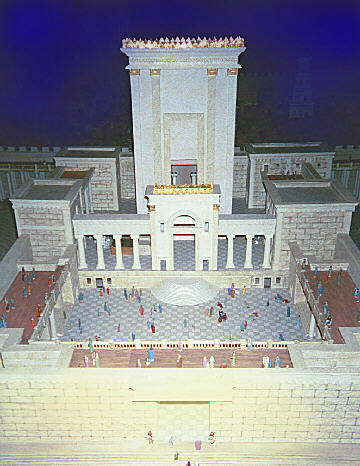The Temple
These photos were taken at the Holyland Experience in Orlando, Florida. The model of the city of Jerusalem as it appeared in A.D. 66 is the work of Zion's Hope Ministries. The model is open for public viewing.
 Herod's Temple
Herod's Temple
The city of Jerusalem had grown extensively since the days of the kings of old. It was now a major metropolis with outlying suburbs. Herod the Great had brought many Hellenistic influences to the city. It now boasted a circus where chariot races could be held as well as a Greek theater.
The city was built upon two parallel ridges which were divided by a steep valley. The lower hill to the east was the site of the original city dating back to the days of the Jebusites. The Temple sat at the northern edge of this ridge.
 View from the Southeast
View from the Southeast
The main entrance to the Temple Mount was through the Hulda Gates, located at the bottom left of the photo. These gates led to a long staircase emerging into the Court of the Gentiles.
Surrounding the Court of the Gentiles were a series of "porches" or cloisters through which ran double rows of Corinthian pillars, each cut from marble and measuring 37 feet in height and covered by a flat roof. The entire court was paved with marble. The southern of these porches was known as "Solomon's Porch" (Acts 3:11).
The Court of the Gentiles derived its name from the fact that Gentiles were permitted into this area provided they conducted themselves in a reverent manner.
The tower in the foreground was the "Place of Trumpeting" and was also known as the Pinnacle of the Temple. It was from this vantage point that the trumpet would be sounded to signal the beginning of the sacrifices.
 The Inner Courts
The Inner Courts
The Court of the Women was not exclusive to women. It was called this because this was as far within the Temple as women were permitted to enter. The court was surrounded by colonnades. Along the walls there were thirteen jars which served as recepticals for various offerings.
Worshipers would come in and drop their offering into one of the jars. It was in such a manner that Jesus and His disciples would have watched the poor widow bringing her offering into the Temple (Mark 12:43).
On the west side of the Court of Women were 15 steps that led up to the Nicanor Gate, also made of Corinthian Brass. This gate led into the inner courtyard of the Temple.
The inner courts were made up of the Court of the Men, the Court of the Levites, and the Court of the Priests. Within the Court of the Priests there were the Altar and the Laver.
The altar was made of rough, unhewn stones. It stood 15 feet high and was surrounded by a raised platform so that the priests could reach its surface. In contrast to the Altar of Incense within the Temple, this altar was used for sacrificing animals.
The Laver was an immense brass bowl of water originally supported by the statues of twelve oxen, though they were removed in the days of King Ahaz (2 Kings 16:17). It was drained every evening and refilled each morning. It was also known as the "sea." This is significant when we read in Revelation 4:5 of the Throne of God, the elders and a sea of glass like crystal.
Twelve more steps led up to the Temple itself. Two great columns flanked the doors leading into the Temple. Only the priests were permitted through these doors and only at the appropriate times.